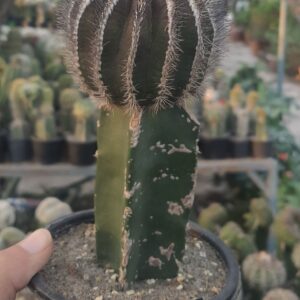Tephrocactus alexandrii “🌵✨ The uncommon and exceptional cactus gem, Tephrocactus alexandrii
Tephrocactus alexandrii, a rare and interesting cactus species within the Opuntioideae subfamily, is highly valued for its distinctive, segmented, tuberous development and beautiful spines. It originates in the high deserts of Argentina, particularly the Andean area, where it flourishes in harsh, rocky conditions with strong sunlight and extreme temperature fluctuations.
In contrast to conventional columnar or globular cacti, Tephrocactus alexandrii develops in a succession of rounded, jointed pieces that are stacked on top of each other in a way that is both uneven and fascinating. Collectors, especially those who like unusual or difficult cactus kinds, appreciate this unique growth habit, as well as its strong spines and versatility.
Botanical Overview
Tephrocactus alexandrii is its scientific name.
Alexandri’s Tephrocactus is the common name.
Family: Cactaceae
Opuntioideae is the subfamily.
Northwest Argentina is where it originated.
Growth Pattern: Segmented, clumping cactus with cylindrical to globular joints
Dimensions:
Height: Typically ranges from 15 to 30 cm (6 to 12 inches)
Sections: Each section has a diameter of around 3–5 cm (1–2 inches).
USDA Hardiness Zones: 9b–11
🌸 Blooms
Late spring to summer is when it blooms.
Flowers:
Tiny and cup-shaped
creamy white or yellow to pale yellow
Show up on adult segments
Although flowers are a benefit for collectors, they are frequently less important than the plant’s structural shape.
The Need for Sunlight
Sunlight:
Does well in full sun to moderate shade
For optimal development, it requires at least six hours of direct sunlight every day.
Afternoon shade can help prevent sun scorching in very hot areas.
Inside:
Location close to a window facing south or west
Additional grow lights might be helpful in areas with low light levels.
A good amount of sunlight is essential for maintaining a small size and a lively spine.
Temperature and humidity
Temperature:
Likes warm weather ranging from 20 to 32 degrees Celsius (68 to 90 degrees Fahrenheit).
If the soil stays dry, it can withstand temperatures as low as -6°C (20°F).
Not frost-hardy; protect from prolonged exposure to below-freezing conditions.
Humidity:
Thrives in environments with low humidity.
The chance of fungal infections or rot can rise with high humidity.
This cactus is well suited to dry, desert-like environments.
💧 Watering schedule
The Growing Season (from Spring to Early Fall):
If the soil is absolutely dry, water well.
Usually every two to three weeks, depending on the weather
Make sure extra water drains entirely to avoid rotting.
At the end of the fall through the winter, there is dormancy.
Watering should be cut back dramatically, to once a month or less.
Refrain from watering in extremely cold weather
Overwatering is the most prevalent danger, particularly in cold or humid environments.
Requirements for the soil
Kind:
A soil combination with excellent drainage is necessary.
Optimal composition:
fifty percent succulent/cactus soil
30% grit or coarse sand
20% perlite or pumice
pH: Between neutral and somewhat alkaline
Plant in wide, low pots with lots of drainage holes for optimal results.
🌾 Feeding
The Growing Season:
Use a diluted cactus fertilizer, such as 5-10-10, once every four to six weeks.
Stay away from fertilizers with a lot of nitrogen since they can lead to stunted development.
Dormancy:
Autumn and winter require no fertilization.
Maintenance and pruning
Pruning:
Usually not required
Use sterile equipment to remove any dead or damaged pieces.
Pests:
Keep an eye out for:
Mealybugs
Scale bugs
Mites of the spider variety
Use isopropyl alcohol swabs or neem oil to treat infestations immediately.
Make sure the air is circulating properly to reduce fungal problems.
🌿 Propagation
By Offsets/Segments:
Gently twist or chop off a piece.
Give the section a few days to callus.
Wait a week after planting in dry, well-drained soil before giving the first gentle watering.
Using Seeds:
Less frequent, but still feasible
Patience is necessary since seed germination is sluggish and seedlings develop slowly.
For hobby gardeners, segment propagation is more dependable and efficient.
Common Problems
Root rot, which results from excessive irrigation or inadequate drainage
Mealybugs and spider mites are pests that may cause issues if the plant is under stress.
Low Growth: Frequently brought on by a lack of light
Most problems may be avoided with regular monitoring and appropriate watering techniques.
🎍 Use for decoration
Ideal for:
Rock Gardens
Landscapes resembling deserts
Displays in containers for unusual cactus collections
Due to its unusual segmented form, it is a conversation starter in any collection.
✅ Conclusion
Collectors looking for something different will find the unusual, sculptural cactus known as Tephrocactus alexandrii to be appealing. When given the right care—plenty of sunshine, little water, and good drainage—its low maintenance requirements, combined with its distinctive segmented growth and fiery spines, make it a satisfying plant.”

Tephrocactus alexandrii
₨799.00
“Belonging to the genus *Tephrocactus*, **Tephrocactus alexandrii** is a unique and uncommon cactus species endemic to Argentina. It is distinguished by its tiny, segmented, round stems that develop in clusters or chains. Each section has sharp, barbed thorns that are simple to remove, allowing the plant to reproduce on its own in the wild.
This cactus grows best in gritty, well-drained soil and direct sunshine. It is very drought-resistant and doesn’t need watering very often, particularly during its winter dormancy. During the growing season, the flowers of the **Tephrocactus alexandrii** plant are often delicate and papery, and come in colors ranging from white to light pink.
Collectors value this cactus for its distinctive growth pattern and prickly texture, making it a great choice for rock gardens, dry environments, and specialized succulent collections.”




Reviews
There are no reviews yet.